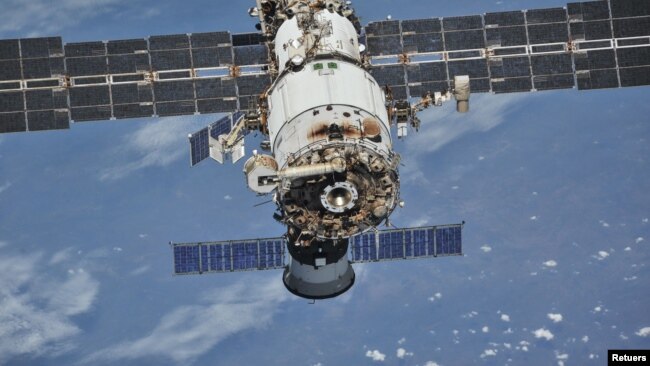スペースジャンクの危険性示唆
以前取り上げたVOAニュース、ロシアが軌道上の衛星をミサイルで爆発実験して多数の破片になったことをアメリカが厳しく批判していた記事の第二弾ですね。国際宇宙ステーション(ISS)の上だろうが下だろうが、関係ないですよね。
問題はやたら衛星が多いことと、その不要になったごみ、さらにゴミを多くする今回のような爆破の破片!!
爆発させた国は、ゴミ収集機だせ!!と叫びたい!!
そのごみ回収を試みるベンチャー企業が日本にあるのです。
さすがです!!
早速、Let's study Englisg with VOA!!
スペースジャンクとは何か、その危険性は? (和訳)
What Is Space Junk and How Dangerous Is it?
アメリカとヨーロッパの政府関係者は、最近行われたロシアのミサイル実験で、軌道上の衛星が爆発して多数の破片になったことを厳しく批判しました。科学者たちは、この軌道上のデブリは、今後何年にもわたって人類とその宇宙での活動に対するリスクを増大させるだろうと述べています。
では、junk宇宙ゴミとも呼ばれるこのデブリとは何なのか、そしてそれがもたらす安全上の脅威とは何なのか。
スペースデブリとは、人間が宇宙に置いたものの使わなくなったもので、地球上の数百キロの上空を浮遊しています。専門家によると、スペースデブリが宇宙ステーションや人工衛星などの機器に衝突することが心配されています。
スペースデブリは、地球低軌道では時速約25,000kmという非常に速いスピードで地球を周回しています。スペースデブリが人工衛星や宇宙船に衝突すると、大きな被害をもたらす可能性があります。
イギリスのサザンプトン大学のProfessor Hugh Lewisヒュー・ルイス教授は、「軌道に乗るすべての衛星は、スペースデブリになる可能性があります」と言います。同大学の宇宙航空研究グループの責任者であるルイス教授は、ロイター通信に次のように述べています。
人工衛星の配備数が増加しているため、地球近傍の宇宙空間では、今後数年のうちにスペースデブリが増える可能性があります。衛星を破壊した国はロシアだけではありません。中国、アメリカ、インドも対衛星ミサイルの実験を行っています。
スペースデブリの大きさはどのくらい?
米国政府は、地球を周回するソフトボールより大きなデブリを約23,000個追跡しています。また、1cm以上のものが約50万個、1mm以上のものが約1億個あります。
Holger Kragホルガー・クラッグ氏は、欧州宇宙機関の宇宙安全プログラムオフィスの責任者です。このままデブリの蓄積が続けば、宇宙の一部の地域が使えなくなるかもしれないとロイターに語っています。
今回の実験では、どのような効果があったのか?
今回ロシアが破壊した衛星は、1982年に打ち上げられたもので、重量は2,000kg以上あります。アメリカ政府の発表によると、今回の実験で1,500個以上の”追跡可能な軌道上のデブリ”が発生したとのことです。米宇宙司令部は、このミサイル攻撃により、さらに数十万個の小さな破片が発生した可能性が高いと述べています。
国際宇宙ステーション(ISS)の乗組員は、実験後2時間は付属の宇宙船カプセルに避難するよう指示されました。これは、デブリの影響でクルーが退避しなければならなくなった場合に備えた安全措置です。
スペースデブリは除去できるのか?
アメリカの宇宙機関であるNASAによると、地球から600km以下の軌道にあるデブリは、数年以内に地球に落下してくるそうです。しかし、1,000km以上の軌道にある宇宙ゴミは、100年以上に渡って回り続けると予想されています。
サウサンプトン大学のprofessor Lewisルイス教授は、「スペースデブリの問題を解決しようとするならば、その種の物体を取り除くことから始めなければなりません」と述べています。日本の宇宙航空研究開発機構(JAXA)や欧州宇宙機関(ESA)は、民間企業と協力して、スペースデブリを除去する方法を模索しています。
スペースデブリは、宇宙の財産や宇宙飛行士にとっての脅威であるだけでなく、衛星運用者にとってもコストの増加につながります。業界の専門家によると、スペースデブリの保護・削減活動は、衛星ミッションのコストの約5〜10%を占めると言われています。経済協力開発機構(OECD)のある調査では、地球低軌道の場合はさらにコストが高くなるとされています。
What Is Space Junk and How Dangerous Is it?
American and European officials sharply criticized Russia’s recent missile test that exploded an orbiting satellite into many pieces. Scientists said this orbiting debris will increase risks to humans and their efforts in space for years to come.
But, what is this debris – also called space junk -- and what are the safety threats it presents?
Space debris is anything humans have placed in space but no longer use. The junk floats around hundreds of kilometers above Earth. Experts say the main worry is that such debris will hit a space station, satellite or other equipment.
Space debris orbits around the Earth very fast - about 25,000 kilometers per hour in low-Earth orbit. The junk could cause major damage if it hits satellites or spacecraft.
"Every satellite that goes into orbit has the potential of becoming space debris," said Professor Hugh Lewis, with Britain’s University of Southampton. Lewis, who heads the university’s Astronautics Research Group, spoke to Reuters news agency.
With the number of satellite deployments rising, near-Earth space will likely see more space debris in the coming years. Russia is not the only country to have destroyed a satellite. China, the United States and India have also carried out anti-satellite missile tests.
How big is the debris?
The U.S. government tracks about 23,000 pieces of debris larger than a softball orbiting the Earth. About 500,000 pieces of debris are larger than one centimeter and 100 million pieces are about one millimeter or larger.
Holger Krag is head of the European Space Agency’s Space Safety Program Office. He told Reuters that if the build-up of debris continues, some areas of space might become unusable.
What was the effect of the latest test?
The satellite Russia just destroyed had been launched in 1982. It weighed more than 2,000 kilograms. American officials said the test created more than 1,500 pieces of "trackable orbital debris." The U.S. Space Command said the missile strike likely created hundreds of thousands of additional smaller pieces of debris.
Crew members aboard the International Space Station (ISS) were directed to take shelter in their attached spaceship capsules for two hours after the test. The safety measure was taken in case the crew had to leave because of possible damage from debris.
Can space debris be removed?
The American space agency NASA says debris in orbits 600 kilometers or less from Earth will fall back to the planet within several years. But space junk above 1,000 kilometers is expected to continue circling for a century or more.
"If we want to try and solve the space debris problem, we have to start to remove that type of object," said professor Lewis of the University of Southampton. Japan's Aerospace Exploration Agency (JAXA) and the European Space Agency (ESA) have partnered with private companies to find ways to remove space debris.
In addition to being a threat to space property and astronauts, debris also increases the cost for satellite operators. Industry experts have estimated that protection and reduction efforts dealing with space junk make up about 5-10 percent of satellite mission costs. One study by the Organization for Economic Co-operation and Development (OECD) found that the costs for lower-Earth orbits were even higher.
Words in This Story
junk – n. material that is no longer working or useful
potential – n. having or showing the capacity to become or develop into something in the future
track – v. to record the progress or development of something
type – n. a kind of something
mission – n. an important project or trip, especially involving space travel
Astroscal :東京のスタートアップ「ELSA-d」テストミッションコンプリート
by Aria Alamalhodaei, Hiroshi Iwatan

米国時間8月25日、Astroscaleは現在軌道上にある同社の宇宙掃除のデモ用衛星が、磁石を使ったシステムでクライアントの宇宙船をつかまえて放す作業に成功し、今後の前進に向けて重要な一歩を刻んだ。
2021年3月に打ち上げられたELSA-d(End-of-Life Services by Astroscale-demonstration)ミッションは、同社の軌道上のデブリ除去技術を検証することを目的としている。デモを行なうための装備等一式はカザフスタンからソユーズロケットで打ち上げられ、宇宙ゴミを除去する「サービサー」と、かんじんの宇宙ゴミを模した「クライアントという2つの宇宙船が含まれている。
軌道上のデブリという問題に取り組んでいる企業は数社あるが、デブリ除去のデモミッションを打ち上げたのは同社が初めてだ。NASAによると現在、国防総省のグローバル宇宙監視センサーは2万7000ほどの軌道上デブリを追跡している。宇宙船の打ち上げと関連の費用が下がり続けているため、宇宙ゴミの量は今後増え続ける一方だろう。
以下の動画では、ミッションのオペレーションチームがテストのデモを説明している。
